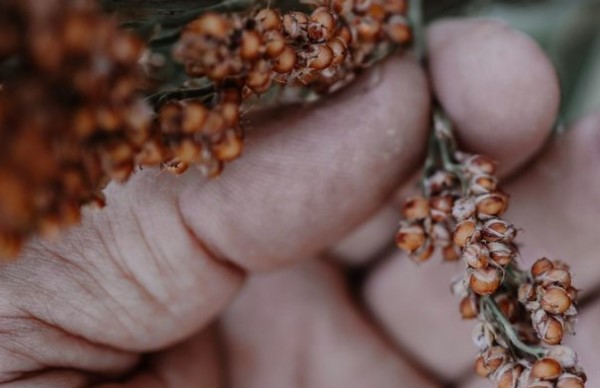
Agricultural News
The Truth About Tannins from Sorghum Grower Magazine
Wed, 17 Nov 2021 10:15:13 CST
 The Fall 2021 edition of Sorghum Grower magazine is now available online! This issue is focused on discovering some truths about sorghum and gaining some historical perspective on some of the terms and technologies we use today.
The Fall 2021 edition of Sorghum Grower magazine is now available online! This issue is focused on discovering some truths about sorghum and gaining some historical perspective on some of the terms and technologies we use today.
Here is one of the featured articles in this season's magazine, by John Duff:
Tannins are largely a mystery to many sorghum farmers. Most know they help keep birds from feasting on sorghum and the associated palatability reduction in tannin sorghum can be detrimental in the marketplace. But what are tannins, how common are they and can they be an asset?
USDA Agricultural Research Service Research Sorghum Geneticist Chad Hayes, Ph.D., shed some light on these questions and explained some exciting new research where tannins are being used in the effort to fight cancer.
Anti-Cancer Properties Research
"There's some very interesting research showing that sorghum has anti-cancer properties," Hayes said. "Phytochemicals-like tannins-concentrated in sorghum bran coupled with the fiber within the grain have been shown to reduce the risk of colon cancer. It's easy to decorticate the bran and use it as an additive in many food and feed applications."
Hayes also noted the ease with which sorghum breeders can naturally affect tannin genes, giving seed companies ultimate control over the levels of tannin in sorghum.
"We understand quite a bit about the genetics of sorghum tannins," Hayes said. "Historically, breeders would select against tannins, but in fact, many favorable breeding lines from around the world are high in tannin. We have the ability today to use both traditional and molecular breeding techniques to produce sorghum hybrids with just the right amount of tannin for specific markets, or none at all as with commercial sorghum produced in the U.S."
Historical Tannin Presence in the U.S.
While high-tannin sorghum for nutraceutical applications is an exciting development in sorghum research, National Sorghum Foundation Chairman Larry Lambright said, despite some misconceptions, tannin sorghum has not been grown in significant quantities in the U.S. in several decades.
"To the extent that it's even grown in the U.S.," Lambright said, 'it would be 100 percent channeled into specialty health markets and thus will never be found in the commercial sorghum supply chain originating in the U.S."
The reason there has been very little tannin sorghum grown in the U.S. is because it can pose problems for trade due to its lack of palatability and digestibility in the animal feed market. Lambright said it is important for sorghum farmers to tout the fact that commercial U.S. sorghum has no tannins. After setting the record on this point straight, Lambright jumped into the chemistry behind tannins.
What Are Tannins?
"Tannins are phenolic compounds," Lambright said. "Originally, tannin hybrids in the marketplace were intended for bird resistance. Tannin hybrids also tend to accumulate less surface mold and degrade less often under high moisture situations just prior to harvest. They aren't perfect in this regard, but they do tend to be better than non-tannin hybrids."
"The birds don't like tannin because it's bitter," he said. "If there's nothing else for them to eat, they'll do damage, but they prefer not to feed on it. Similarly, it decreases the rate of gain in animals."
Often, darker hybrids are thought to exhibit higher levels of tannin. Lambright characterized this as a common misconception.
"Grain color is not an indication of tannin," Lambright said. "A lot of the tannin types are brown or even a dark purple, but white sorghum can be high in tannins, as well. The compound is held in the testa layer or seed coat. In some cases, it can be visible-and particularly in white hybrids or parent lines. The compound is held in the testa layer beneath the seed coat. You can use a knife or your thumbnail to remove the seed coat and reveal the testa."
Tannins in Other Countries
While the U.S. has greatly steered clear of tannins in commercial sorghum, other countries like Mexico, on its west coast, utilize tannins to repel bird populations. Argentina is also a common source of tannin sorghum for that same reason.
"Argentina historically has grown tannin sorghum to help with bird issues, and there's still a high percentage of their crop that's high in tannins," Lambright said. "They still export a lot of their tannin sorghum. They do have some hybrids that are not high in tannins, but most of those are used domestically. And these statements were especially true in past years."
Now you know the truth about tannins. Strong agronomic management and the elite genetics, coupled with U.S. sorghum absent from tannins, produce high quality grain for both domestic and international end-users.
As for domestic, specialty markets, will tannins be the ticket for future sorghum health claims? Only research and time will tell.
See the digital copy of the fall 2021 edition of Sorghum Grower magazine.
WebReadyTM Powered by WireReady® NSI
Top Agricultural News
More Headlines...




